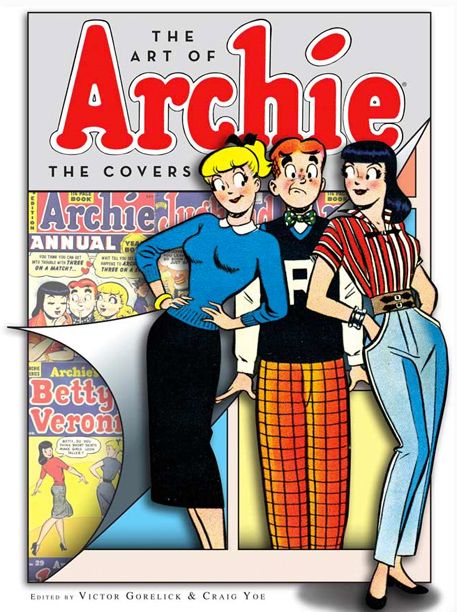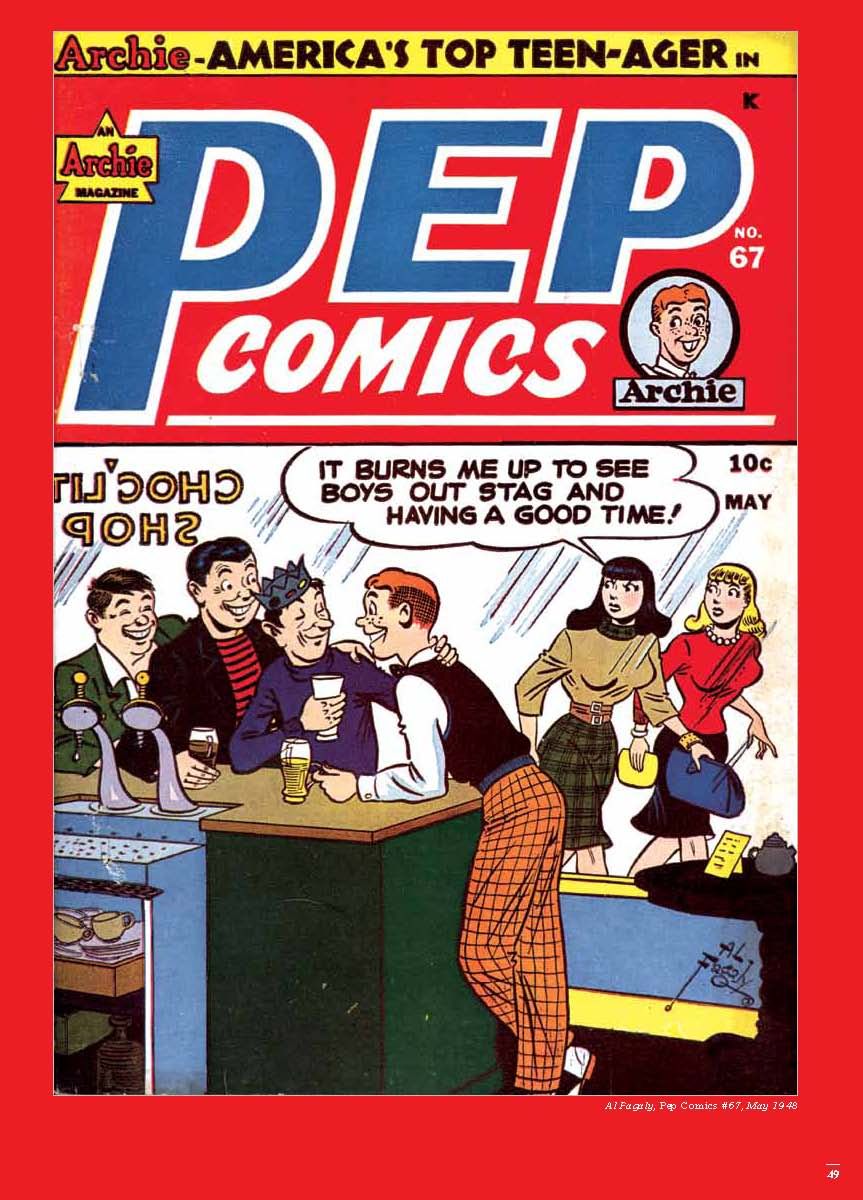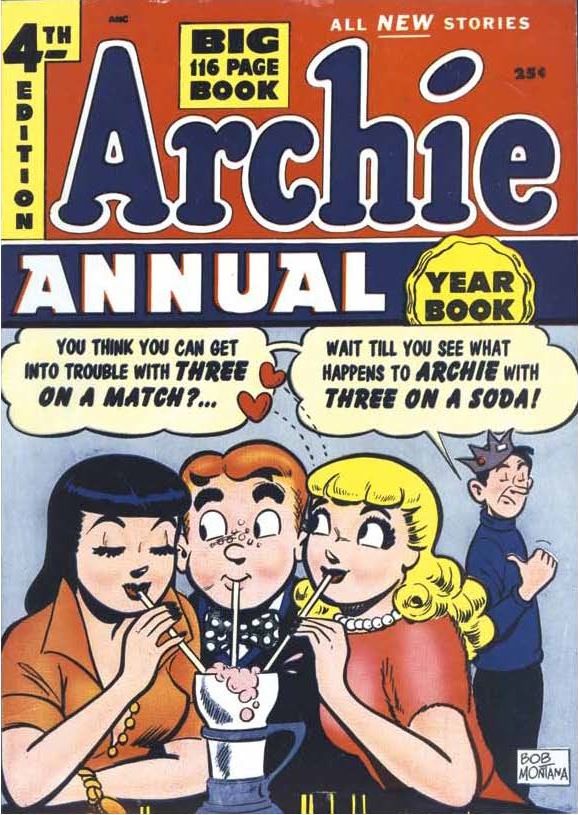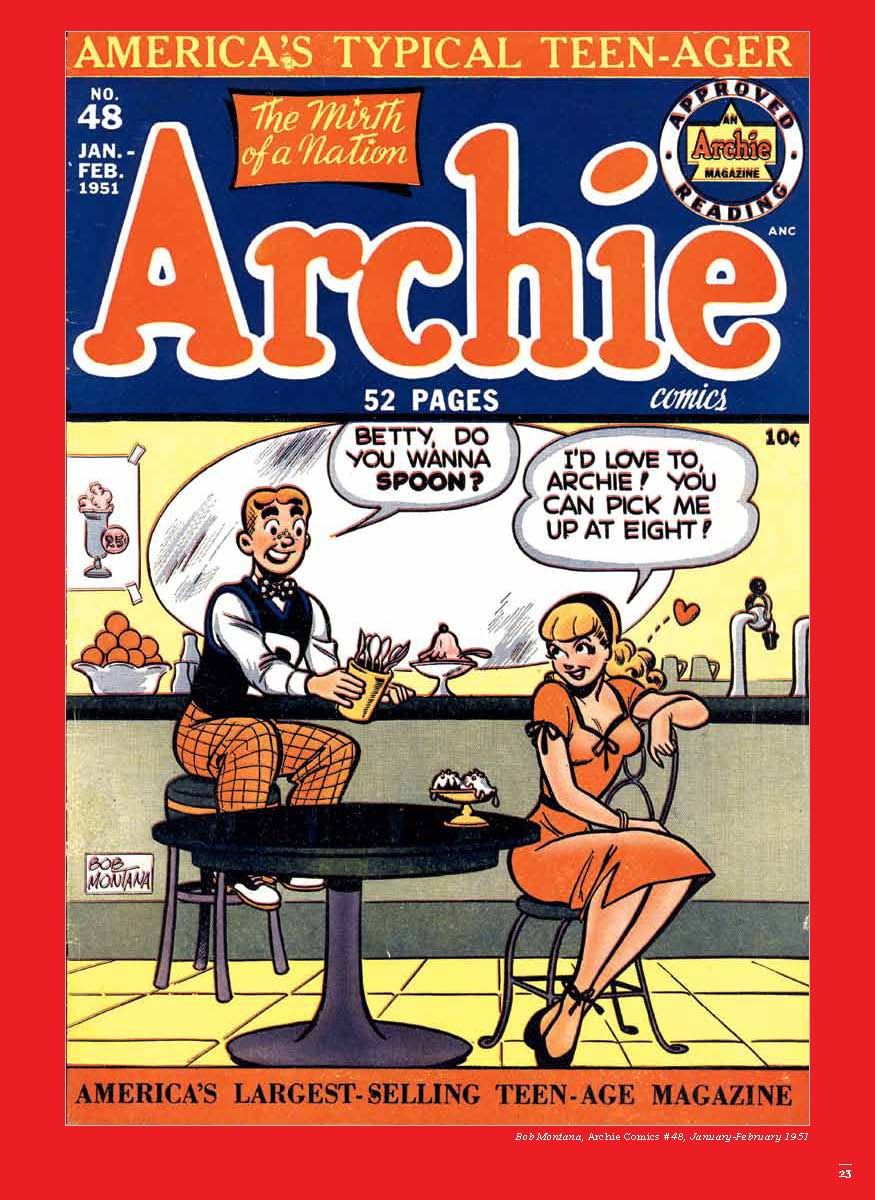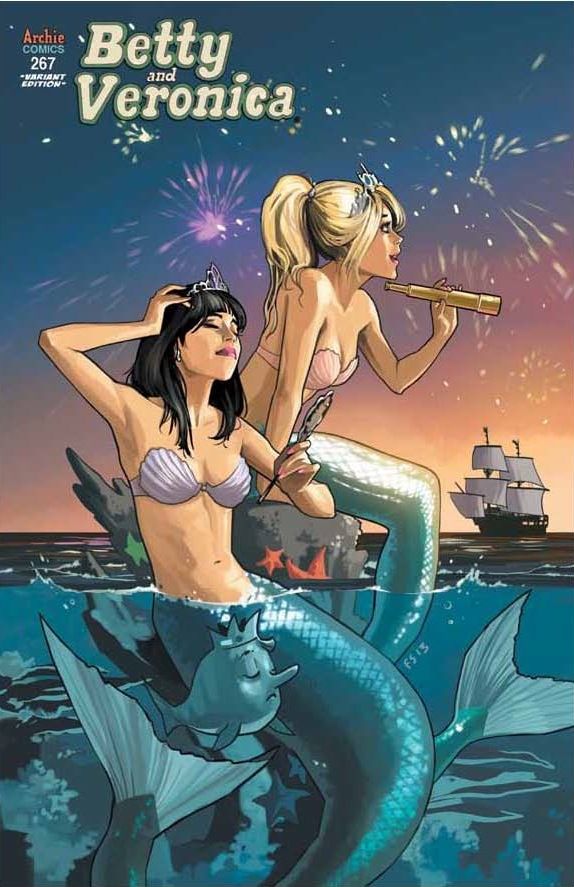Last year, Archie Comics Editor-in-Chief Victor Gorelick and comics historian Craig Yoe compiled The Art of Betty and Veronica, the first art book ever released by the nearly 75-year-old publisher. Now they're back with another deluxe, oversized volume, The Art of Archie: The Covers.
Like their previous book, this is more than just a series of pretty pictures. They kick it off with a look at how a cover is created, contrasting an original sketch by writer George Gladir with a finished cover, then showing the different states of another cover — line art, proofs, and finished product. They also include sections focusing on the individual artists, with a photo of each artist, a brief bio and a sample of his work.
I talked to Gorelick and Yoe about what went into compiling the book — and what went into creating the Archie covers in the first place. Gorelick, who's been with the company for more than 50 years, drew on his own reminiscences about the way things used to happen behind the scenes.
Brigid Alverson: I'm going to start with the obvious question: Why covers?
Victor Gorelick: All of our covers tell a story. It's not just some superhero flying around in some poses; you get a gag on the cover. It's a little bit extra for your money.
Craig Yoe: They are closer to a New Yorker cartoon than a typical comic book cover that is maybe just a scene of action. These do have a nice little scenario and setup and payoff.
Gorelick: And also, we didn't just paste in a bunch of covers. I have seen other cover books where you just see one cover after another. There's a little more background on the covers. There are covers that were chosen by our fans — we put something up on the internet and we asked them to let us know what their favorites are.
The book has sections devoted to different artists as well as an example of the process a cover goes through, from original idea to finished product. Why did you think it was important to include that?
Gorelick: It makes it more interesting. The reader is going to see what goes into putting a comic book cover together
Yoe: I had in my collection the original artwork to the Betty and Veronica Beatles cover. Victor was saying we should find a sketch by [Archie writer] George Gladir to show how covers are created, and then to go on with the Beatles cover, and he turned up the color proofs for the cover, so it really does tell a nice little story about how the covers are created conceptually and drawn and printed.
Gorelick: George Gladir did most of our covers. You see one sketch, but he would send in maybe 25, 30 sketches a week of various covers.
Yoe: The covers do have content. They are little stories, so it's not a surprise that a writer did it. [Writer] E.B. White would come up with ideas for New Yorker covers. It was no surprise to me that George, a writer, was behind many of the great covers in this book.
What kind of archives did you have to work from, and what was your process for going through them and selecting the covers?
Gorelick: We have a lot of bound volumes, going back to the very first Archie comic book, and now we do our archives digitally. Creating the comics has changed over the years from the way it was when I first started working at Archie Comics. We used to receive color proofs from the engraver, and we saved most of them. So Craig and I went through boxes of these cover proofs.
Yoe: Those proofs were really great to see. They don't make them any more, but it's great to see the process. We called on a lot of collectors: Steve Barghusen scanned many covers, I think he has a complete collection, and Jack Copley, he has a pretty complete collection. Steve has helped us on other books too. Then we called on collectors for original artwork. At one point the artwork Archie still had was returned to the artists, and they sold it to collectors. The collectors generously scanned the artwork, and a collector had photographs I had never seen before that were extremely rare of the artists we wanted to feature. So the archives were a combination of what Archie had and what collectors had in their vaults.
The covers have a pretty distinctive look, which changes over the years. Do you know how they were designed and who designed them?
Gorelick: There is one section where we show the Archie covers and explain how each month, back in the day, the Archie logos would alternate, with a red logo one month, a blue one the following month. When you would go to by an Archie comic, hopefully you would remember that last month I bought a red one, now I have to buy a blue one. In the '70s or '80s we started making changes with the logos. We would still alternate the colors, but we would let the artwork run up right through without that masthead line. It changed, depending on what the gag was.
Yoe: Finally artists and writers are being credited, but I don't think we will ever be able to tell who was the art director or the graphic designer.
Gorelick: Each month when the covers are close to ready, we review them, and it's not just one or two people — we'll have practically the whole art department gather around the table, and we will lay out the covers for that month and make suggestions. We might make the logo bigger or smaller, make it red, change it to blue. All we are getting is the artwork, and we put it together here. Now we are doing variant covers on a lot more books, so a lot of people are involved in coming up with what the covers look like. We also want to make sure the covers are really different color-wise from one another — if you see a couple of covers together and they are all the same color, you might not be able to pick up on it.
Yoe: I wish we knew who in the 1940s came up with the look that did go for a number of decades, that red, white and blue. It was probably because of the war at the time. The subhead on the Archie comics was "America's typical teenager," so it was very patriotic to have that red, white, and blue. But the designers in those days are totally anonymous and forgotten. It might even have been the cartoonists — it might have been Bob Montana or Bill Vigoda.
Gorelick: I would guess it was probably made by the editor and publisher.
Yoe: But did they design the covers? They might have said "Let's do red, white and blue," but who came up with the Archie logo? I don't think we will ever know.
Gorelick: The very first Archie logo was kind of crude. Somewhere along the line, somebody really sat down and lettered those logos meticulously.
So there was no single art director?
Gorelick: No. It was always more than one person who put their two cents in on the cover.
Yoe: My guess is there was somebody who was kind of in an art director role, but we are still trying to figure out the artists and writers of comics in that era.
Do you know who the creators are for the covers?
Yoe: Victor was able to identify the vast majority of them, but there were still a couple of covers [...] we don't know.
Gorelick: In some cases the artists would work on them together. One artist might ink another artist's pencils, and vice versa, so their style might change the look of the characters a little bit. So it was hard to tell who did what.
Yoe: I think what's great now is that Jon Goldwater and Victor want to make sure the artists are getting credit for their work. Now they are well known and sign their work, but the comic book industry in the past didn't always have that. Some of the artists didn't want to have credit — they thought comic books were beneath them, or for tax reasons they didn't want the government to know they were getting so much work. Sometimes artists were moonlighting for a company and didn't want them to know they were doing work for their competitors. For many reasons artists didn't get credit.
At what point in the process of creating a comic were the covers chosen?
Gorelick: We used to pick out the covers way before we worked on the books.
So the covers came first?
Gorelick: Yes. We have always worked on our books by season. We would have our summer covers, our winter covers, in the winter we would have Christmas covers, but we always put those aside earlier. I would put all the cover sketches together and give them to the artist, and one week they would work only on the covers. Most of the covers were done by the same artist -- Dan DeCarlo was getting covers, Stan Goldberg, Samm Schwarz for his book in particular, Jughead — but the covers were done ahead of time. Now we are working far in advance with our covers because we need to solicit them five or six months ahead of time.
Yoe: Archie, far more than any other company, had covers that were seasonal. You could always look forward to Betty and Veronica in their bikinis. Dell maybe did a lot of Christmas covers, but I don't think any company was as seasonal as Archie, or as topical. Archie is always on top of fads, teenagers, what was going on in the world. Most of the other companies were doing covers that were just humorous.
Gorelick: In the springtime I might be calling up George Gladir and saying, "Let's do some back-to-school covers," and in the summer I'd tell him, "Time to start working on Christmas covers."
Yoe: George would always follow the news
Gorelick: He was living in California. All those fads would start in California and work their way East.
Yoe: Victor tells me George would send in a cover gag and maybe a newspaper clip from California to back up his gag idea.
Gorelick: Only because it was so outlandish you wouldn't believe it, but here it was in the newspaper. He once sent me a gag with Betty and Veronica wearing these raincoats that were made out of clear vinyl, and they were wearing bikinis underneath. Things like that.
Were the covers interchangeable? Or was there a particular style of cover for Laugh, say, versus Pep or Archie's Joke Book?
Gorelick: Some of the covers could have been interchangeable, particularly with Laugh and Pep. Usually we would pick out covers specifically for an Archie cover or a Betty and Veronica cover. Some could have been interchangeable, but for the most part we were picking them out specifically for that issue.
Laugh and Pep always featured an Archie-type story for the lead, then there was a Little Jinx story, or it could have been Katy Keene, and another extra character story, and a pen pal page. Those two books were pretty much the same, but we would use them as a vehicle to introduce new characters
Did you ever have to kill a cover?
Gorelick: I know of one offhand. It wasn't that there was anything inappropriate, just the way it was laid out -- it was supposed to be a Betty cover, and Betty was hanging off the side of a building and someone was trying to get her off the roof. It was awful.
Yoe: I'm amazed not at what might have gotten killed but at what didn't get killed. Going through these covers, I am amazed at how sexy some of them are-in good taste and racy. Betty and Veronica are hot on these covers from all the eras. I'm surprised how risqué they were on some covers. It's good, wholesome entertainment, but those artists sure could draw the ladies in a very appealing way.
Gorelick: We had a couple of covers that I had to make some adjustments to before we sent them out, because some of he artists had a habit of really overemphasizing certain parts of their anatomy. We used up a lot of white paint. When Twiggy was popular, the publisher at that time instructed the artists to follow that look with the girls. The trend was a little flatter.
Yoe: And sales became flat, so Veronica was restored to her former glory
Gorelick: Eventually they came back. But it's interesting, back in the '40s, the girls looked much older. They are only supposed to be 16 and a half, but girls always matured more than boys did anyway.
Yoe: And the fashions weren't that different from adult fashions.
Do you have any favorites?
Gorelick: A couple of Bob Montana covers are definitely my favorite covers.
Yoe: Montana was really a brilliant artist. He didn't do a lot of covers, but those covers I just think are incredible. I do love the covers by Harry Lucey and Dan DeCarlo, and then Fernando Ruiz and Dan Parent are doing great stuff now. It's hard to choose.
Gorelick: Now we are doing a lot of variant covers, so we are getting artists from all over the industry.
What's the next book?
Gorelick: Pin-ups! The Art of Archie: Pin-Ups. We are working on it as we speak.
Yoe: Especially in the '60s, there were a lot of pin-up pages, beyond just gorgeous pages of Betty and Veronica -- Mr. Weatherbee and Miss Beazley are in pin-ups too. Just as there was a story and a gag in the covers, the same was true with pin-ups. These pin-ups are very, very entertaining, content-wise, so it's going to be a really fun book.
Gorelick: Most of the pin-ups were done by Dan DeCarlo. He sort of started doing them one day and he kept doing them. In fact, a couple of times we took a pin-up and used it for a cover.


